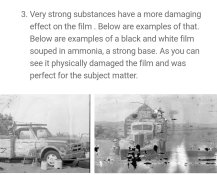nothinghappened
Member
Hi!
My goal is to reproduce the deterioration given by time on some photos taken years ago.
Visually, I'd like to get damage on the emulsion (abrasions, holes, scratches) but in a totally random way.
I've been looking for a way to corrode enlargements made on x-ray film lately, but I'm having a bit of difficulty.
By immersing photographic films in undiluted hydrochloric acid (15-30%), corrosion is visible already after 5 minutes, while with x-ray films I didn't get any effect even after an hour or more, but the emulsion to fade away.
Yesterday I tried ammonia (30%) with dilution 1+19, 1+10, 1+4 and 1+1, but it did not give results in the medium term (2 hours of immersion).
What else could I use to try and ruin these plates?
Thank you in advance for your help!
PS: I attached the kind of results I'm looking for.
This guy used ammonia, but he doesn't say dilution or waiting time.
My goal is to reproduce the deterioration given by time on some photos taken years ago.
Visually, I'd like to get damage on the emulsion (abrasions, holes, scratches) but in a totally random way.
I've been looking for a way to corrode enlargements made on x-ray film lately, but I'm having a bit of difficulty.
By immersing photographic films in undiluted hydrochloric acid (15-30%), corrosion is visible already after 5 minutes, while with x-ray films I didn't get any effect even after an hour or more, but the emulsion to fade away.
Yesterday I tried ammonia (30%) with dilution 1+19, 1+10, 1+4 and 1+1, but it did not give results in the medium term (2 hours of immersion).
What else could I use to try and ruin these plates?
Thank you in advance for your help!
PS: I attached the kind of results I'm looking for.
This guy used ammonia, but he doesn't say dilution or waiting time.












